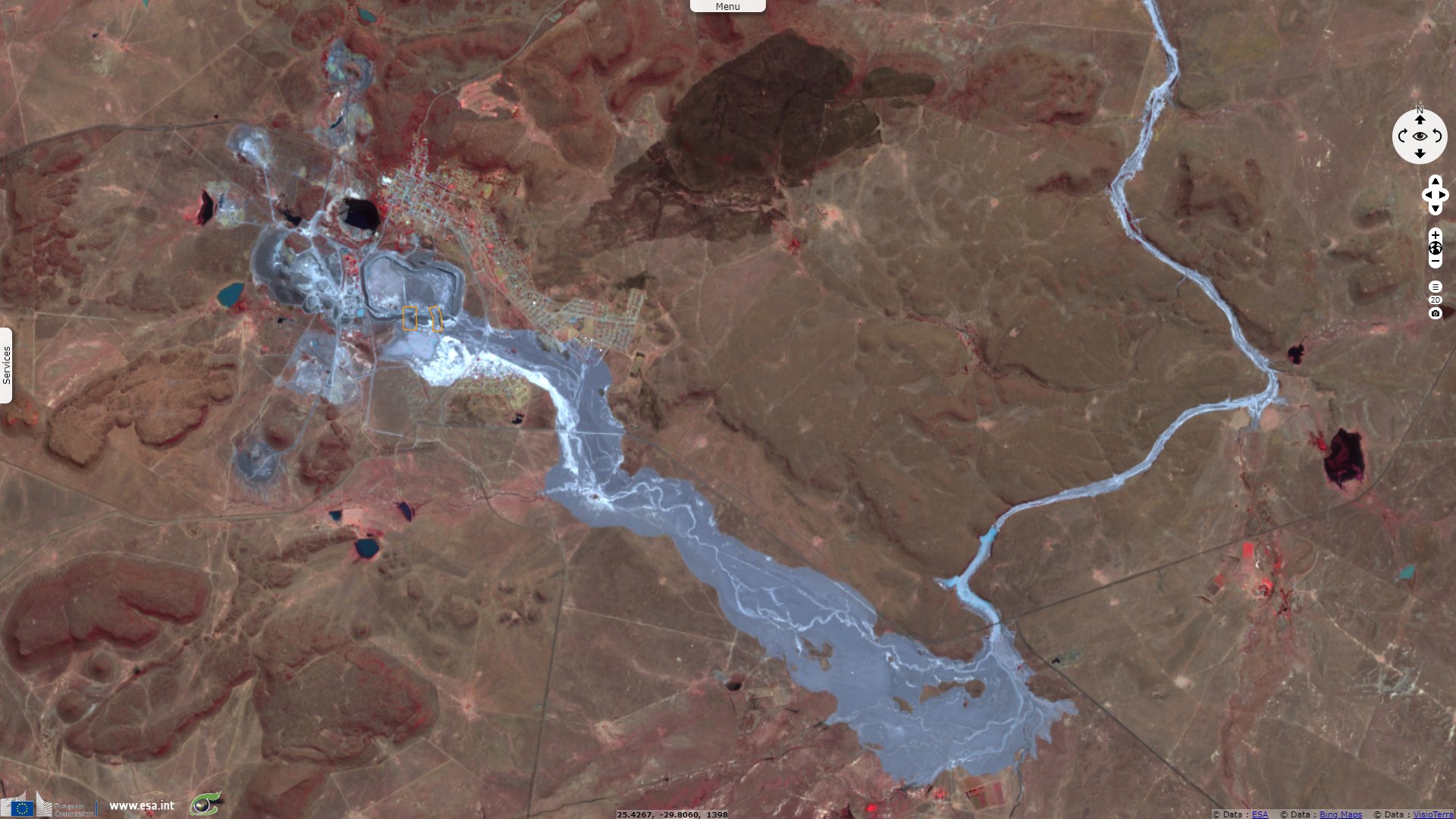Deadly dam collapse in a diamond mine, RSA
Sentinel-1 CSAR IW acquired on 18 August 2022 at 17:02:29 UTC
...
Sentinel-2 MSI acquired on 06 September 2022 at 07:56:21 UTC
Sentinel-1 CSAR IW acquired on 11 September 2022 at 17:02:30 UTC
Sentinel-2 MSI acquired on 16 September 2022 at 07:56:21 UTC
...
Sentinel-2 MSI acquired on 06 September 2022 at 07:56:21 UTC
Sentinel-1 CSAR IW acquired on 11 September 2022 at 17:02:30 UTC
Sentinel-2 MSI acquired on 16 September 2022 at 07:56:21 UTC
Keyword(s): Emergency, flooding, tailing dam, diamond mine, hydrology, RSA, South Africa
On 11 September 2022, the tailings dam of a diamond mining reprocessing area collapse in the mining city of Jagersfontein, South Africa. Floodlist describes the ensuing event: "A wall of a mining dam, also known as a tailings dam, broke in the early hours causing floods, mud and debris to flow into nearby settlements. Homes were damaged or destroyed and residents force to flee. Authorities said the disaster has left hundreds of people destitute. At least 3 people have lost their lives and 4 are missing, while around 40 people were taken to hospital including 23 with hypothermia and 4 with broken limbs."
Dave Petley Professor in Geology and Vice-Chancellor of the University of Hull in the United Kingdom studied the case. In a first post, he notes: "The mine’s dumps and slime still “belong” to De Beers and the government’s access has been restricted by a court order, [Nathi] Shabangu [a spokesman the Department of Mineral Resources and Energy] said. “We also have reports that the mine has been sold to other parties, without the involvement of the DMRE as per the court order,” he said. Reports indicate that at least three people have been killed and about 40 people have been hospitalised by the failure."
In another post he adds: "Finally, it now appears that the ownership of this facility changed earlier this year, and that at the time of failure it was owned by Jagersfontein Developments, part of the Dubai-based Stargems Group. Reuters reports that the approach has been to reprocess the tailings to recover diamonds that have been accidentally dumped. It also reports that operations were stopped in 2020 due to high water levels, but that they resumed in 2021."
"The plume of tailings extends about 8.5 km towards the southeast. It is up to about 1.5 km wide. The image shows a large breach in the southern wall of the facility. It appears that the pond, which is about 1 km long and 500 m wide, has largely emptied. Many houses downstream of the facility have been inundated. Worryingly, the satellite images also indicate that the tailings have entered the main channel."
Gill Gifford deals with the remaing health hazards in the South African Sunday Times: "environmental governance specialist Carin Bosman noted the spill had demolished the local sewerage works, meaning raw sewage was now flowing untreated into the stream, with dam tailings. 'It has already gone down the stream quite a bit and will soon reach the Kalkfontein Dam, which is a source of water supply for a number of towns in the area, including Jagersfontein and Fauresmith. Urgent action is needed ... as the raw sewage is creating a health risk for everyone and the lack of water supply will worsen it,' she said. Alternative sanitation and berms were needed to prevent slimes and untreated sewage from reaching the dam before it rains."
Investigating the cause of the failure, Dave Petley concludes more areas are to be monitored in South Africa: "Inevitably, there is a great deal of interest in what happened at the Jagersfontein tailings dam site of the in the period leading up to the failure. One key question is whether the facility fell between regulatory stools because it was a reprocessing centre rather than an active mine. It appears from the satellite imagery that old spoil heaps were being “mined”, with the waste being stored in a greatly expanded tailings storage facility. Operations were suspended at least once, reportedly because of concerns about regulatory compliance. Reports indicate that there are 400 more tailings facilities in South Africa. In 2020, 52 of these were classified as being "active high risk tailings dams"."










